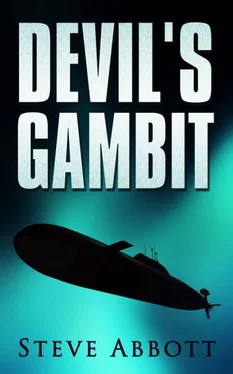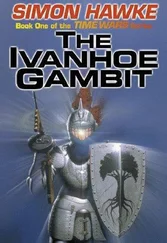The diving officer took over and barked out the proper sequence of commands to all crew concerned. The Captain struggled into his wet weather gear as he stood under the bridge hatch and waited. The all clear sounded. The ladder to the bridge was short. The hatch undogged and pushed open easily. Sea water trapped in the locking ring poured over the Captain. Another baptism done, he clambered up onto the small open-air bridge.
All around, the sky was dark and leaden. A squall line was moving in from the south. They would have to work fast before the squall overtook them and made the transfer an impossible task.
The brisk sea air and salt spray were welcome sensations after the stale metallic air and cramped confines of the Leader. The Captain breathed them all down deep. With his bridge key, he unlocked the watertight container around the bridge intercom system. He put the headset inside on, over his Captain’s cap, and started to relay commands to the helm. The freighter loomed ahead of them, a dirty wall of white paint, rust and neglect. Because the Leader had a single, centrally mounted screw, which was partially exposed when surfaced, the boat’s surface speed was not as fast as the Captain would like. The Leader’s round, cigar-shaped hull caused it to roll considerably when topside, even in moderately rough seas.
He gripped the small helm wheel at the front of the open-air bridge. “I have the helm. Ahead full and get me a signalman up here.”
“Transferring to bridge helm control. Aye, sir.”
The signalman arrived on the open bridge in record time. The Captain gave him a moment to also savor the fresh air before giving him the message to send. It was little things that made a crew go the extra distance for you. “Tell them to start their replenishment at sea drill. I will pull into their lee side. When we have matched speeds, I’ll draw alongside.”
The signalman began to clatter out the Captain’s message on his signal lamp. A few minutes later, the Nung Il Yeung started to come to starboard, bringing her in a parallel path with the sub. Large bumpers were lowered from the freighter’s deck. There to protect the sub’s anechoic tiles. It took nearly forty minutes of messages and curses before the two vessels were parallel in a way the Captain of the Leader was happy with. The sea was calmer in the lee of the Nung.
A narrow black channel of water sluiced between the two crafts; a reminder that the sea around them was ever ready to claim another of the unwary. This close to the freighter and in the lee, the roar of the wind sucked the power out of all voice. Yelling was not the Captain’s style. He tapped his signalman on the arm with the back of his right hand.
“I need to know the number and size of the transferring cargo.”
The signalman nodded and started on the new message.
The Captain waited for his answer. Signaling Morse with a light was not the most rapid form of communication. Four minutes later, the signalman handed the Captain the freighter’s reply. He read it. “Those idiots!” He keyed the intercom, “Get me the political officer up here, now!”
The officer climbed through the man way before the Captain’s hand had left his throat switch. He had been waiting at the foot of the ladder. The Captain fought the urge to kick the political officer in the head as he climbed out. Instead he thrust the message sheet in front of the man’s face. “What the hell were you people thinking?”
Political officers, used to being in the position of power, do not scare easily. “Do not forget who you are talking to, Captain.”
“I ought to throw you and your friend over the side!”
The officer pulled himself onto the small and increasingly cramped bridge. He straightened his wet weather gear as he spoke in a bored tone, “What is the problem?”
“Read the sheet, man. Read the sheet.” He thrust the message at the officer again.
He read it. “I still fail to see the problem.”
It was too much. The Captain grabbed the officer by his tie and pulled him towards the circular hole of the weather bridge’s circular hatch. With his free hand, he pointed at the offending opening. “One meter by a half meter high? Do these crates bend like rubber or were you going to use magic to get them inside my boat? Our dear Leader will be more than pleased with the extent of your planning.” He let go of the man’s tie.
The officer stood up, his face purple, trying to stammer out a reply, “I, I …”
“Don’t even bother to try explaining, Comrade.” He spat out the last word. “I have a plan, but if one of my men is hurt or killed carrying out what we must do, I swear you and your friend go swimming as enemies of the People.”
The political officer was still breathing heavily. “But how will … You just said?”
“Be very glad, Comrade officer. Be glad you have me and my crew here. Your cargo will have to be loaded through the torpedo bay hatch.”
The man’s eyes widened in disbelief. “In these seas? Beside that thing?” He turned only to watch a wave break around the bow of the freighter. “We will swamp and sink for sure.”
The Captain yelled to the signalman, “Tell them we will have to make the transfer with their crane though the front torpedo loading hatch.”
With a nod, the signalman set about relaying the new set of instructions.
The Captain clicked his throat mike. “First officer, we’re going to have to manage the transfer through the front torpedo hatch. Get the men in place and things underway.”
The reply was a tinny “Aye, sir” over his headset.
The Captain pushed the political officer to one side, so that he could view his men at work. A hatch at the forward base of the sail swung out and a seaman appeared with a line tied about his waist. He started down the twenty meter distance, to the edge of the forward torpedo loading hatch. In his hands was a metal post. Another seaman appeared at the sail hatch. His job was to keep the line tight and provide a point of balance for the steadily advancing man.
The submarine and the freighter took on a steady, rhythmic roll. The iron wall of the freighter appeared to be stationary to the sailor’s eye while the inner ear told the body a different story. His efforts became more forced as he neared the hatch.
The Captain was relieved to see the heavy duty bumpers deployed were doing their job, saving their anechoic tiles from damage. The seaman made it to the torpedo hatch. He slid the base of the post into a socket beside the hatch and, with a twist, secured it in place. Untying the line from around his waist and holding the post for support, the line was threaded through an eyelet at the post’s top. The seaman at the bow waved back to the one waiting at the sail hatch, who pulled the line tight and tied it off to the bulkhead. He and three other seamen clipped safety tethers to the line and moved to join their comrade. They took more poles and line to secure a safety barrier around the forward hatch. More precious minutes were lost while the cordon was erected around the still-closed hatch. They waved back to the bridge when they were ready.
The Captain called to the signalman. “Tell the freighter to keep our speeds matched.” He relayed the speed required for the next set of maneuvers by intercom to his first officer. “Make turns for four knots. Open the forward torpedo loading hatch when we are at speed.”
The signalman turned to his Captain, “They are signaling they will comply, sir.”
The headset buzzed in his ears, “Fours knots, sir.”
“Good, we’re coming alongside now. Open the forward hatch.”
The forward hatch began to hinge upwards on hydraulic supports. The four seamen took up positions at each corner of the hatch. The roll of the sub made walking too deadly a risk. If a man slipped or fell, he would be crushed between the two hulls or cut to bits by the leader’s screw.
Читать дальше












